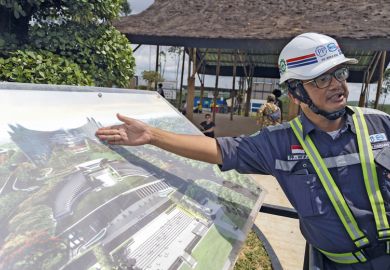More than half of the population of Asia and the Pacific region live in cities and about a billion more people are expected to join them by the middle of the century. Of the world’s 33 “megacities” – defined as being home to more than 10 million citizens – 17 can be found here.
With such rapid and intensive urbanisation come challenges. Take Jakarta, for example, which is densely populated, highly polluted and has begun to sink into the ocean – problems so seemingly intractable that, instead of attempting to fix them, Indonesia has instead decided to relocate the country’s capital to a different island entirely.
Although other leaders in the region are yet to take such drastic action, many of Asia’s megacities face similar problems as the effects of climate change and population growth mount.
For students and academics, this presents an opportunity – knowing how to better design, plan and manage cities are skills that are both in demand and offer them the chance to meaningfully improve the lives of those around them. Similarly, more research into urbanisation – once concentrated in Europe and America – is urgently needed to help Asia’s cities develop sustainably and face the environmental challenges ahead.
“It is widely acknowledged that Asia is the fastest-urbanising region in the world, with the speed and scale of change causing massive disruption to pre-existing ways of living, working, governing and more,” said Orlando Woods, director of the recently opened Urban Institute at Singapore Management University (SMU).
“Academic research that focuses explicitly on Asian cities is needed to understand, help manage and ideally help mitigate the deleterious effects of these changes.”
A 2020 study of built environment professionals in Commonwealth countries found a “critical lack of capacity” in many of the countries that are rapidly urbanising, including India and Pakistan, which are projected to experience the world’s largest increases in their urban populations by 2050, alongside Nigeria.
“There is not nearly enough expertise to deliver the cities and towns that are needed,” said Stephen Cairns, professor of urban design at Monash University Indonesia. “Demand for urban designers is growing in Indonesia, with almost all the major developers employing them.”
While some institutions have been training students to plan and manage cities for decades – the University of Hong Kong claims to be the first in Asia to have offered a postgraduate programme in urban design, launching a master’s degree in 1988 – many universities in the region are introducing new programmes to help meet the demand for what were once seen as relatively niche skills.
Monash, for example, offers nine postgraduate degree programmes in Indonesia, one of which is urban design. The course description cites the demand for “skilled urban designers who can create sustainable and liveable cities for future generations”.
“As urban challenges become more prominent, educational institutions are expanding their offerings and students are increasingly aware of the career opportunities in urban management,” said Yau Yung, professor of urban studies at Hong Kong’s Lingnan University.
Lingnan began offering a PhD course in urban studies in September 2023, building on a cities and governance master’s that was launched in 2020. According to Professor Yau, although fewer than 20 students originally enrolled on the master’s, this has now increased to around 70.
“Urban design programmes are increasingly popular in Hong Kong and beyond due to a progressive understanding of the value of urban design for cities,” said Gianni Talamini, an associate professor in the department of architecture and civil engineering at City University of Hong Kong.
For students interested in cities, there are a number of options, including planning, design and management – or some combination of all three. Urban studies is also a research area in its own right, taking a multidisciplinary approach to understanding cities.
“This interdisciplinary nature attracts a diverse range of students, making it a more popular choice than in the past,” said Professor Yau.
A distinctly Asian approach to these subjects is also emerging. While much of urban planning and design has traditionally been rooted in North American and European scholarship, there is a growing acceptance that these Anglocentric approaches might not be fit for the future and academics in the region are keen to make space for something new.
“One of the primary issues we tackle is the radically different kind of urbanisation pressure that is shaping the settlement patterns of southeast, east and south Asia,” said Monash’s Professor Cairns. “This basic fact means that we have to think about and practise urban design in quite different ways. It’s an exceptionally challenging and exciting context.”
POSTSCRIPT:
Print headline: Asia responds to the fast growth of cities
Register to continue
Why register?
- Registration is free and only takes a moment
- Once registered, you can read 3 articles a month
- Sign up for our newsletter
Subscribe
Or subscribe for unlimited access to:
- Unlimited access to news, views, insights & reviews
- Digital editions
- Digital access to THE’s university and college rankings analysis
Already registered or a current subscriber?








